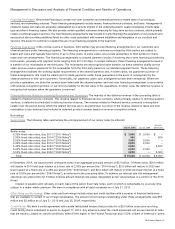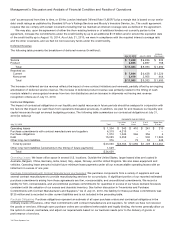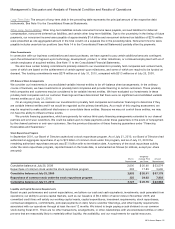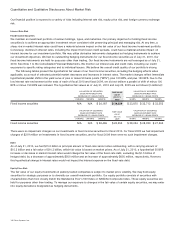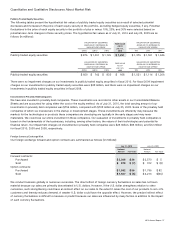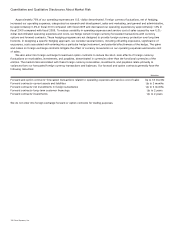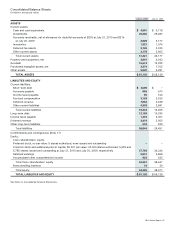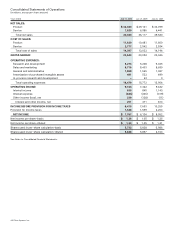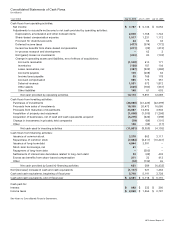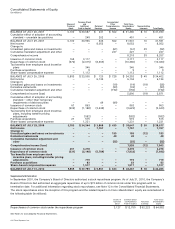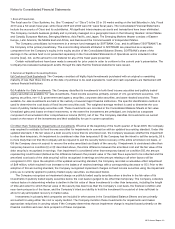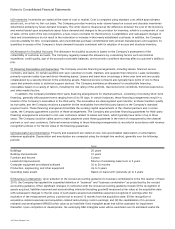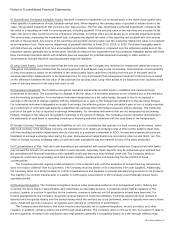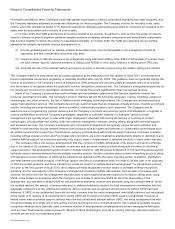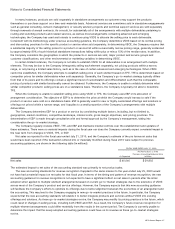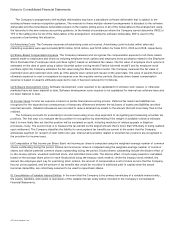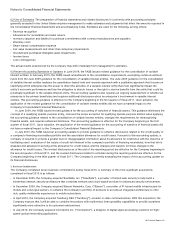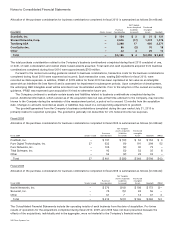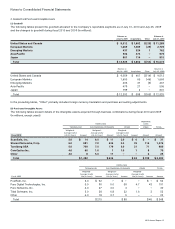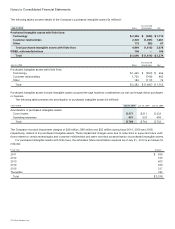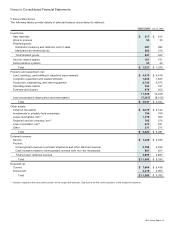Cisco 2010 Annual Report Download - page 45
Download and view the complete annual report
Please find page 45 of the 2010 Cisco annual report below. You can navigate through the pages in the report by either clicking on the pages listed below, or by using the keyword search tool below to find specific information within the annual report.
Notes to Consolidated Financial Statements
1. Basis of Presentation
The fiscal year for Cisco Systems, Inc. (the “Company” or “Cisco”) is the 52 or 53 weeks ending on the last Saturday in July. Fiscal
2010 was a 53-week fiscal year, while fiscal 2009 and 2008 were 52-week fiscal years. The Consolidated Financial Statements
include the accounts of Cisco and its subsidiaries. All significant intercompany accounts and transactions have been eliminated.
The Company conducts business globally and is primarily managed on a geographic basis in the following theaters: United States
and Canada, European Markets, Emerging Markets, Asia Pacific, and Japan. The Emerging Markets theater consists of Eastern
Europe, Latin America, the Middle East and Africa, and Russia and the Commonwealth of Independent States.
The Company consolidates its investment in a venture fund managed by SOFTBANK Corp. and its affiliates (“SOFTBANK”) as
the Company is the primary beneficiary. The noncontrolling interests attributed to SOFTBANK are presented as a separate
component from the Company’s equity in the equity section of the Consolidated Balance Sheets. SOFTBANK’s share of the
earnings in the venture fund is not presented separately in the Consolidated Statements of Operations and is included in other
income (loss), net, as this amount is not material for any of the fiscal years presented.
Certain reclassifications have been made to amounts for prior years in order to conform to the current year’s presentation. The
Company has evaluated subsequent events through the date that the financial statements were issued.
2. Summary of Significant Accounting Policies
(a) Cash and Cash Equivalents The Company considers all highly liquid investments purchased with an original or remaining
maturity of less than three months at the date of purchase to be cash equivalents. Cash and cash equivalents are maintained with
various financial institutions.
(b) Available-for-Sale Investments The Company classifies its investments in both fixed income securities and publicly traded
equity securities as available-for-sale investments. Fixed income securities primarily consist of U.S. government securities, U.S.
agency securities, non-U.S. government and agency securities, corporate debt securities, and asset-backed securities. These
available-for-sale investments are held in the custody of several major financial institutions. The specific identification method is
used to determine the cost basis of fixed income securities sold. The weighted-average method is used to determine the cost
basis of publicly traded equity securities sold. These investments are recorded in the Consolidated Balance Sheets at fair value.
Unrealized gains and losses on these investments, to the extent the investments are unhedged, are included as a separate
component of accumulated other comprehensive income (AOCI), net of tax. The Company classifies its investments as current
based on the nature of the investments and their availability for use in current operations.
(c) Other-than-Temporary Impairments on Investments Effective at the beginning of the fourth quarter of fiscal 2009, the Company
was required to evaluate its fixed income securities for impairments in connection with an updated accounting standard. Under this
updated standard, if the fair value of a debt security is less than its amortized cost, the Company assesses whether the impairment
is other than temporary. An impairment is considered other than temporary if (i) the Company has the intent to sell the security, (ii) it
is more likely than not that the Company will be required to sell the security before recovery of the entire amortized cost basis, or
(iii) the Company does not expect to recover the entire amortized cost basis of the security. If impairment is considered other than
temporary based on condition (i) or (ii) described above, the entire difference between the amortized cost and the fair value of the
debt security is recognized in earnings. If an impairment is considered other than temporary based on condition (iii), the amount
representing credit losses (defined as the difference between the present value of the cash flows expected to be collected and the
amortized cost basis of the debt security) will be recognized in earnings and the amount relating to all other factors will be
recognized in OCI. Upon the adoption of the updated accounting standard, the Company recorded a cumulative effect adjustment
of $49 million, which resulted in an increase to the balance of retained earnings with a corresponding decrease to OCI. Prior to the
adoption of this accounting standard, the Company recognized impairment charges on fixed income securities using the impairment
policy as is currently applied to publicly traded equity securities, as discussed below.
The Company recognizes an impairment charge on publicly traded equity securities when a decline in the fair value of its
investments in publicly traded equity securities below the cost basis is judged to be other than temporary. The Company considers
various factors in determining whether a decline in the fair value of these investments is other than temporary, including the length
of time and extent to which the fair value of the security has been less than the Company’s cost basis, the financial condition and
near-term prospects of the issuer, and the Company’s intent and ability to hold the investment for a period of time sufficient to
allow for any anticipated recovery in market value.
Investments in privately held companies are included in other assets in the Consolidated Balance Sheets and are primarily
accounted for using either the cost or equity method. The Company monitors these investments for impairments and makes
appropriate reductions in carrying values if the Company determines that an impairment charge is required based primarily on the
financial condition and near-term prospects of these companies.
2010 Annual Report 43


